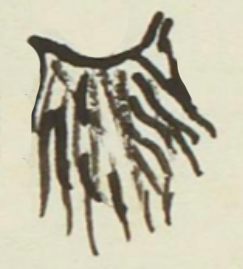Zacatilma (MH574r)
This black-line drawing of the simplex glyph for the personal name Zacatilma (“Grass Cape,” attested here as a man’s name) shows a full view of a cape (tilmatli) with an extended tie and grass or straw (zacatl) hanging down from the tie.
Stephanie Wood
The tilma was a garment worn by men. It was an attire often reserved for the elite of society. This one, being made of zacate, which was rough, might have been more accessible to humbler men. Manuel Orozco y Berra noted that these capes were worn by rural people who wanted to protect themselves from the rain. Other names for these capes were zacaquequemitl and pachón, the latter being Spanish for fuzzy. [See: Historia antigua y de la conquista de México: 1.pte (1880, 488).]
Stephanie Wood
peo. Çacatilma
Pedro Zacatilma
Stephanie Wood
1560
Jeff Haskett-Wood
grasses, straw, hay, hierbas, paja, tilmas

zacatilma(tli), a straw or grass cape, https://nahuatl.wired-humanities.org/content/zacatilmatli
zaca(tl), grasses, hay, bulrushes, https://nahuatl.wired-humanities.org/content/zacatl
tilma(tli), cape or cloak, https://nahuatl.wired-humanities.org/content/tilmatli
Matrícula de Huexotzinco, folio 574r, https://www.loc.gov/resource/gdcwdl.wdl_15282/?sp=227&st=image
This manuscript is hosted by the Library of Congress and the World Digital Library; used here with the Creative Commons, “Attribution-NonCommercial-ShareAlike 3.0 License” (CC-BY-NC-SAq 3.0).








